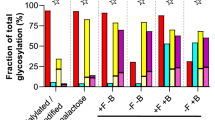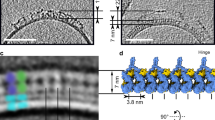Abstract
Complement is an ancient danger-sensing system that contributes to host defense, immune surveillance and homeostasis1. C5a and its G protein–coupled receptor mediate many of the proinflammatory properties of complement2. Despite the key role of C5a in allergic asthma3, autoimmune arthritis4, sepsis5 and cancer6, knowledge about its regulation is limited. Here we demonstrate that IgG1 immune complexes (ICs), the inhibitory IgG receptor FcγRIIB and the C-type lectin–like receptor dectin-1 suppress C5a receptor (C5aR) functions. IgG1 ICs promote the association of FcγRIIB with dectin-1, resulting in phosphorylation of Src homology 2 domain–containing inositol phosphatase (SHIP) downstream of FcγRIIB and spleen tyrosine kinase downstream of dectin-1. This pathway blocks C5aR-mediated ERK1/2 phosphorylation, C5a effector functions in vitro and C5a-dependent inflammatory responses in vivo, including peritonitis and skin blisters in experimental epidermolysis bullosa acquisita. Notably, high galactosylation of IgG N-glycans is crucial for this inhibitory property of IgG1 ICs, as it promotes the association between FcγRIIB and dectin-1. Thus, galactosylated IgG1 and FcγRIIB exert anti-inflammatory properties beyond their impact on activating FcγRs.
This is a preview of subscription content, access via your institution
Access options
Subscribe to this journal
Receive 12 print issues and online access
$209.00 per year
only $17.42 per issue
Buy this article
- Purchase on Springer Link
- Instant access to full article PDF
Prices may be subject to local taxes which are calculated during checkout




Similar content being viewed by others
References
Ricklin, D., Hajishengallis, G., Yang, K. & Lambris, J.D. Complement: a key system for immune surveillance and homeostasis. Nat. Immunol. 11, 785–797 (2010).
Klos, A. et al. The role of the anaphylatoxins in health and disease. Mol. Immunol. 46, 2753–2766 (2009).
Köhl, J. et al. A regulatory role for the C5a anaphylatoxin in type 2 immunity in asthma. J. Clin. Invest. 116, 783–796 (2006).
Hashimoto, M. et al. Complement drives TH17 cell differentiation and triggers autoimmune arthritis. J. Exp. Med. 207, 1135–1143 (2010).
Rittirsch, D. et al. Functional roles for C5a receptors in sepsis. Nat. Med. 14, 551–557 (2008).
Markiewski, M.M. et al. Modulation of the antitumor immune response by complement. Nat. Immunol. 9, 1225–1235 (2008).
Clynes, R., Dumitru, C. & Ravetch, J.V. Uncoupling of immune complex formation and kidney damage in autoimmune glomerulonephritis. Science 279, 1052–1054 (1998).
Wenderfer, S.E. et al. C5a receptor deficiency attenuates T cell function and renal disease in MRLlpr mice. J. Am. Soc. Nephrol. 16, 3572–3582 (2005).
Ji, H. et al. Arthritis critically dependent on innate immune system players. Immunity 16, 157–168 (2002).
Shushakova, N. et al. C5a anaphylatoxin is a major regulator of activating versus inhibitory FcγRs in immune complex–induced lung disease. J. Clin. Invest. 110, 1823–1830 (2002).
Godau, J. et al. C5a initiates the inflammatory cascade in immune complex peritonitis. J. Immunol. 173, 3437–3445 (2004).
Nimmerjahn, F. & Ravetch, J.V. Fcγ receptors as regulators of immune responses. Nat. Rev. Immunol. 8, 34–47 (2008).
Strait, R.T., Morris, S.C. & Finkelman, F.D. IgG-blocking antibodies inhibit IgE-mediated anaphylaxis in vivo through both antigen interception and FcγRIIb cross-linking. J. Clin. Invest. 116, 833–841 (2006).
Jones, S.L., Knaus, U.G., Bokoch, G.M. & Brown, E.J. Two signaling mechanisms for activation of αMβ2 avidity in polymorphonuclear neutrophils. J. Biol. Chem. 273, 10556–10566 (1998).
Otto, M. et al. C5a mutants are potent antagonists of the C5a receptor (CD88) and of C5L2: position 69 is the locus that determines agonism or antagonism. J. Biol. Chem. 279, 142–151 (2004).
Taylor, P.R. et al. The β-glucan receptor, dectin-1, is predominantly expressed on the surface of cells of the monocyte/macrophage and neutrophil lineages. J. Immunol. 169, 3876–3882 (2002).
Goodridge, H.S. et al. Activation of the innate immune receptor dectin-1 upon formation of a 'phagocytic synapse'. Nature 472, 471–475 (2011).
Taylor, P.R. et al. Dectin-1 is required for β-glucan recognition and control of fungal infection. Nat. Immunol. 8, 31–38 (2007).
McDonald, J.U. et al. In vivo functional analysis and genetic modification of in vitro–derived mouse neutrophils. FASEB J. 25, 1972–1982 (2011).
Rogers, N.C. et al. Syk-dependent cytokine induction by dectin-1 reveals a novel pattern recognition pathway for C type lectins. Immunity 22, 507–517 (2005).
Wex, E. et al. Induced Syk deletion leads to suppressed allergic responses but has no effect on neutrophil or monocyte migration in vivo. Eur. J. Immunol. 41, 3208–3218 (2011).
Dennehy, K.M., Klimosch, S.N. & Steinle, A. Cutting edge: NKp80 uses an atypical hemi-ITAM to trigger NK cytotoxicity. J. Immunol. 186, 657–661 (2011).
Nimmerjahn, F. & Ravetch, J.V. Divergent immunoglobulin g subclass activity through selective Fc receptor binding. Science 310, 1510–1512 (2005).
Malhotra, R. et al. Glycosylation changes of IgG associated with rheumatoid arthritis can activate complement via the mannose-binding protein. Nat. Med. 1, 237–243 (1995).
Raju, T.S. Terminal sugars of Fc glycans influence antibody effector functions of IgGs. Curr. Opin. Immunol. 20, 471–478 (2008).
Geijtenbeek, T.B. & Gringhuis, S.I. Signalling through C-type lectin receptors: shaping immune responses. Nat. Rev. Immunol. 9, 465–479 (2009).
Barb, A.W. & Prestegard, J.H. NMR analysis demonstrates immunoglobulin G N-glycans are accessible and dynamic. Nat. Chem. Biol. 7, 147–153 (2011).
Wernersson, S. et al. IgG-mediated enhancement of antibody responses is low in Fc receptor γ chain–deficient mice and increased in Fc γ RII–deficient mice. J. Immunol. 163, 618–622 (1999).
Sitaru, C. et al. Induction of dermal-epidermal separation in mice by passive transfer of antibodies specific to type VII collagen. J. Clin. Invest. 115, 870–878 (2005).
Yoshitomi, H. et al. A role for fungal β-glucans and their receptor dectin-1 in the induction of autoimmune arthritis in genetically susceptible mice. J. Exp. Med. 201, 949–960 (2005).
Manicassamy, S. et al. Toll-like receptor 2–dependent induction of vitamin A–metabolizing enzymes in dendritic cells promotes T regulatory responses and inhibits autoimmunity. Nat. Med. 15, 401–409 (2009).
Anthony, R.M., Wermeling, F., Karlsson, M.C. & Ravetch, J.V. Identification of a receptor required for the anti-inflammatory activity of IVIG. Proc. Natl. Acad. Sci. USA 105, 19571–19578 (2008).
Arnold, J.N., Wormald, M.R., Sim, R.B., Rudd, P.M. & Dwek, R.A. The impact of glycosylation on the biological function and structure of human immunoglobulins. Annu. Rev. Immunol. 25, 21–50 (2007).
Agarwal, S. & Cunningham-Rundles, C. Autoimmunity in common variable immunodeficiency. Curr. Allergy Asthma Rep. 9, 347–352 (2009).
Nimmerjahn, F. & Ravetch, J.V. Analyzing antibody-Fc-receptor interactions. Methods Mol. Biol. 415, 151–162 (2008).
Graham, I.L., Anderson, D.C., Holers, V.M. & Brown, E.J. Complement receptor 3 (CR3, Mac-1, integrin alpha M beta 2, CD11b/CD18) is required for tyrosine phosphorylation of paxillin in adherent and nonadherent neutrophils. J. Cell Biol. 127, 1139–1147 (1994).
Wang, G.G. et al. Quantitative production of macrophages or neutrophils ex vivo using conditional Hoxb8. Nat. Methods 3, 287–293 (2006).
Rosas, M. et al. The induction of inflammation by dectin-1 in vivo is dependent on myeloid cell programming and the progression of phagocytosis. J. Immunol. 181, 3549–3557 (2008).
Wedepohl, S. et al. N-glycan analysis of recombinant L-selectin reveals sulfated GalNAc and GalNAc-GalNAc motifs. J. Proteome Res. 9, 3403–3411 (2010).
Acknowledgements
This work is supported by the German Research Foundation (Deutsche Forschungsgemeinschaft, GRK1727; project 8 and SFB/TR22; project A21) to J.K., EXC306/1 to D.Z., R.L. and J.K., and by Deutsche Forschungsgemeinschaft EH221-5 to M.E. P.R.T. is a Medical Research Council (UK) Senior Fellow (G0601617). G.D.B. was supported by the Wellcome Trust. We thank T. Köhli for technical assistance with the surface plasmon resonance analysis, T. Gutsmann for help with the fluorescence spectroscopy measurements, T. Peters and L. Wollin for helpful discussions and B. Heyman (Uppsala University, Sweden) for providing the H5 and the 7B4 hybridoma clones.
Author information
Authors and Affiliations
Contributions
C.M.K. and M.K.P. conducted key studies and analyzed the data. J.F. assessed antigen binding of in vitro–glycosylated IgGs and performed phenotypical characterization of bone marrow cells, and some in vivo studies. R.K. and C.M.K. performed the EBA studies. R.L. and D.Z. provided the rabbit collagen type VII–specific IgG for the EBA studies and helped with EBA-related data analysis. P.R.T., M.R. and J.U.M. provided the dectin-1–transduced neutrophil and macrophage cell lines, and helped with assays using such lines. S.J.O. performed the peptide pull-down experiments. M.B., D.P. and V.B. did the MALDI-TOF analysis. A.W. and C.H. performed the in vitro galactosylation of the H5 antibody. G.D.B. and D.M.R. provided the Clec7a−/− mice and helped with the neutrophil assays using such mice and with ex vivo assays with primary Clec7a−/− cells. I.V.M. provided material and advice for the FRET experiments. R.T.S. and F.D.F. provided TNP-OVA and helped with initial IC studies. N.L.H. and G.K. performed the ERK phosphorylation studies with neutrophils. E.W. provided the conditional Syk-knockout mice and the protocol for in vitro Syk depletion. F.N. provided the recombinant IgG1 7B4 antibody and recombinant mouse FcγRIIB-Fc and assessed HiGalH5-IC and H5-IC binding to FcγRIIB-transfected Chinese hamster ovary cells. M.E. provided scientific input and coordinated the glycan analysis. J.K. designed and coordinated the study, analyzed the data and wrote the manuscript.
Corresponding author
Ethics declarations
Competing interests
E.W. is an employee of Boehringer Ingelheim Pharma.
Supplementary information
Supplementary Text and Figures
Supplementary Figures 1–23 and Supplementary Table 1 (PDF 4835 kb)
Supplementary Movie 1
Expression of FcγRIIB but absence of Syk phosphorylation in untreated BM neutrophils. This movie shows the expression pattern of FcγRIIB (green, anti-FcγRIIB-FITC Ab) and of phosphorylated Syk (p-Syk, magenta, anti–p-Syk–Alexa568 Ab) in a BM-derived neutrophil 3 min after incubation with PBS, as determined by confocal microscopy in an animated three-dimensional projection. Cell stains positive for FcγRIIB. No phosphorylation of Syk is visible in the absence of 107.3-IC treatment. Similar results were obtained for p-SHIP. (MOV 1966 kb)
Supplementary Movie 2
Expression of dectin-1 but absence of Syk phosphorylation in untreated BM neutrophils. This movie shows the expression pattern of dectin-1 (magenta, anti–dectin-1–APC Ab) and phosphorylated Syk (p-Syk, green, anti–-p-Syk–Alexa568 Ab) in a BM-derived neutrophil 3 min after incubation with PBS, as determined by confocal microscopy in an animated three-dimensional projection. No phosphorylation of Syk occurs in the absence of 107.3-IC treatment. Similar results were obtained for p-SHIP. (MOV 1340 kb)
Supplementary Movie 3
Phosphorylation of Syk and co-localization of p-Syk with FcγRIIB in response to 107.3-IC treatment. This movie shows the co-localization pattern of FcγRIIB (green, anti-FcγRIIB-FITC Ab) and of phosphorylated Syk (p-Syk, magenta, anti-p-Syk-Alexa568 Ab) in a BM-derived neutrophil 3 min following 107.3-IC treatment, as determined by confocal microscopy in an animated three-dimensional projection. 107.3-IC treatment drives phosphorylation of Syk; p-Syk co-localizes with FcγRIIB as indicated by the white spots. Similar results were obtained for p-SHIP. (MOV 2750 kb)
Supplementary Movie 4
Phosphorylation of Syk and co-localization of p-Syk with dectin-1 in response to 107.3-IC treatment. This movie shows the co-localization pattern of dectin-1 (magenta, anti–dectin-1–APC Ab) and phosphorylated Syk (p-Syk, green, anti-p-Syk-Alexa568 Ab) in a BM-derived neutrophil 3 min following 107.3-IC treatment, as determined by confocal microscopy in an animated three-dimensional projection. 107.3-IC treatment drives phosphorylation of Syk; p-Syk co-localizes with dectin-1 as indicated by the white spots. Similar results were obtained for p-SHIP. (MOV 1771 kb)
Supplementary Movie 5
107.3-IC treatment promotes association of FcγRIIB and dectin-1. This movie shows the co-localization pattern of FcγRIIB (green, anti-FcγRIIB-FITC Ab) and of dectin-1 (magenta, anti–dectin-1–APC Ab) in a BM-derived neutrophil 3 min after incubation with IgG1 IC, as determined by confocal microscopy in an animated three-dimensional projection. Co-localization of FcγRIIB and dectin-1 is indicated by the white spots. (MOV 1271 kb)
Rights and permissions
About this article
Cite this article
Karsten, C., Pandey, M., Figge, J. et al. Anti-inflammatory activity of IgG1 mediated by Fc galactosylation and association of FcγRIIB and dectin-1. Nat Med 18, 1401–1406 (2012). https://doi.org/10.1038/nm.2862
Received:
Accepted:
Published:
Issue Date:
DOI: https://doi.org/10.1038/nm.2862
This article is cited by
-
Immune regulatory networks coordinated by glycans and glycan-binding proteins in autoimmunity and infection
Cellular & Molecular Immunology (2023)
-
Glycobiology of rheumatic diseases
Nature Reviews Rheumatology (2023)
-
Treatment with β-Adrenoceptor Agonist Isoproterenol Reduces Non-parenchymal Cell Responses in LPS/D-GalN-Induced Liver Injury
Inflammation (2023)
-
Comparative analysis of transferrin and IgG N-glycosylation in two human populations
Communications Biology (2023)
-
Baseline IgG-Fc N-glycosylation profile is associated with long-term outcome in a cohort of early inflammatory arthritis patients
Arthritis Research & Therapy (2022)



